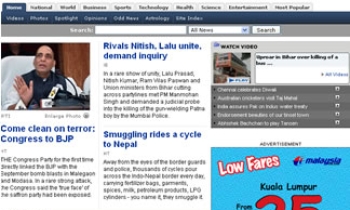The Washington Post is a bloated newspaper that should cut its voluminous and often dull output by a third to attract more readers, some say.
The Washington Post's rich offerings have attracted an incredibly loyal core of readers who would be alienated by a drastic personality change, others say.
The people who hold these divergent views all work for the capital's biggest paper, and they are firing away in daily in-house electronic critiques that have sparked an impassioned debate about The Post's future.
Business columnist Steven Pearlstein calls the critiques "almost revolutionary for this newsroom. It's allowing children into the adult conversation, and it turns out the children have thought about this and have some ideas, some of which [top editors] don't like and some of which they do."
Associate Editor Robert Kaiser says he was "quite skeptical in the beginning," but has been impressed that rank-and-file staffers "have the oomph to stand up and say what they think, which is often charmingly and radically at odds with what The Post is thinking."
But political reporter Dana Milbank is unimpressed, writing that with few exceptions, "this has been an elaborate exercise in navel gazing."
Who needs bloggers when your own employees are taking such shots?
Arguments about what readers want have become almost an obsession after an 18-year slide in national newspaper circulation and an economic squeeze that is prompting such giants as the New York Times, Boston Globe and Philadelphia Inquirer to cut newsroom jobs. Post daily circulation recently dropped 2.7 percent, to 752,000, from the previous year, down from a high of 839,000 in the early 1990s.
Some say readers have simply migrated to The Post's Web site (4.9 million unique visitors in August, according to Comscore Networks) and its free tabloid, the Express. But many staffers are using the forum to raise fundamental questions about the paper's mission.
The rhetoric heated up when Pearlstein wrote that Post staffers should "admit that a lot of what we do, and how we do it, is driven by a notion of good journalism that has more to do with 'dominating' a story and keeping up with the competition or, on occasion, winning prizes, than it does with what our readers need and want. . . . Too many of our stories . . . [have] 'obligation' written all over them."
Pearlstein called for a smaller, edgier paper and complained that the opinion pages have become "too tame, too predictable, too R-E-S-P-O-N-S-I-B-L-E and, at times, downright boring."
Kaiser, while agreeing that some Post stories are too bureaucratic or duplicative, wrote that home subscribers have remained steadfast and "they love The Post. Do we want to change the paper in ways that might lose that loyalty in order to try to win the loyalty of people who in fact may never be inclined to buy an ink-on-paper newspaper? . . . I think the rich mixture that is The Post is perhaps our greatest single asset. Steve's proposal would undermine it profoundly."
Executive Editor Leonard Downie calls the critiques "a good dialogue" and says the paper has already been trimming the lengths of stories, trying to rein in overlapping pieces and using more graphics. He says Pearlstein "hasn't really thought through carefully" the impact of a one-third reduction, which would leave less room for advertising. "We want to be able to serve a lot of different kinds of readers with one newspaper. While people say the size of the newspaper bothers them, they all want to find what they want to read in the newspaper."
Dozens of staffers have participated in the critiques. Business reporter Sara Kehaulani Goo wrote: "Don't give me 4 stories on the same topic in one day because there's no way I'm going to read it all. (Exception: Hurricane Katrina). Okay, I'm taking on the Pope here, but we often have way too many stories here on the same official Washington news for one reader to absorb."
Style staffer Hank Stuever wrote that "we've overlistened to people who never read the paper. . . . Why are we obsessed with the paper being too much, too large?"
On Thursday, Book World Editor Marie Arana, noting that she had been "a Young Republican at 15, a marching SDSer at 20, and roundly disgusted by the blue-team, red-team political dialogue by the time I turned 30," criticized an article on what was called a "stealth evangelism" festival by saying: "The elephant in the newsroom is our narrowness. Too often, we wear liberalism on our sleeve and are intolerant of other lifestyles and opinions. . . . We're not very subtle about it at this paper: If you work here, you must be one of us. You must be liberal, progressive, a Democrat. I've been in communal gatherings in The Post, watching election returns, and have been flabbergasted to see my colleagues cheer unabashedly for the Democrats."
Downie says he is concerned if some staffers are openly displaying political preferences but that Arana's comments were valuable and "made clear that we do have a diverse staff when it comes to ideological backgrounds."









